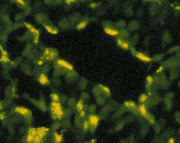Vaccination, immunostimulation and regulation of T-cells
Vaccination, immunostimulation and regulation of T-cells
Central cells in the innate defense are different phagocytes, granulocytes, dendritic cells, natural killer cells and gamma delta T-cells. These cells are localised to many different tissues and organs, notably to mucous tissues. Central molecules in the innate defense are pathogen-associated molecular patterns (PAMPs), proinflammatory cytokines and a vast number of opsonic molecules that ease further immune responses.
The research group focus on both innate and adaptive mechanisms in both salmon and the cleanerfish, Atlantic lumpsucker. In particular, T-cell differentiation systems during vaccination, immunostimulation and infection are under study.
Contact persons: Drs. Roy A. Dalmo and Tore Seternes
 |
 |
|
| Fish macrophage with attached and ingested nanoparticle vaccine. | Salmon endothelial cells and macrophages loaded with ß-glucan. | Simplified overview of T-cell activation and differentiation. |